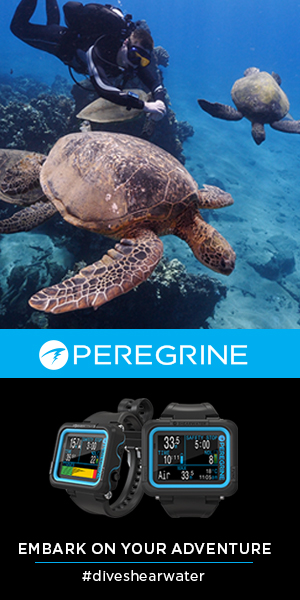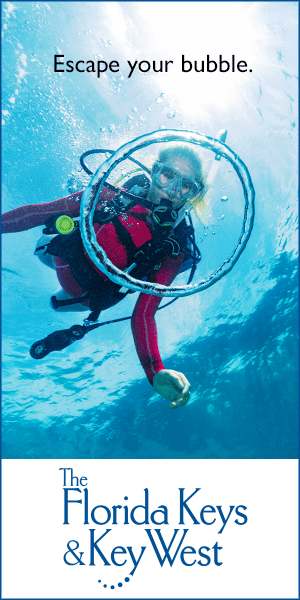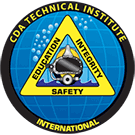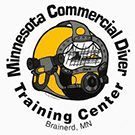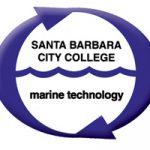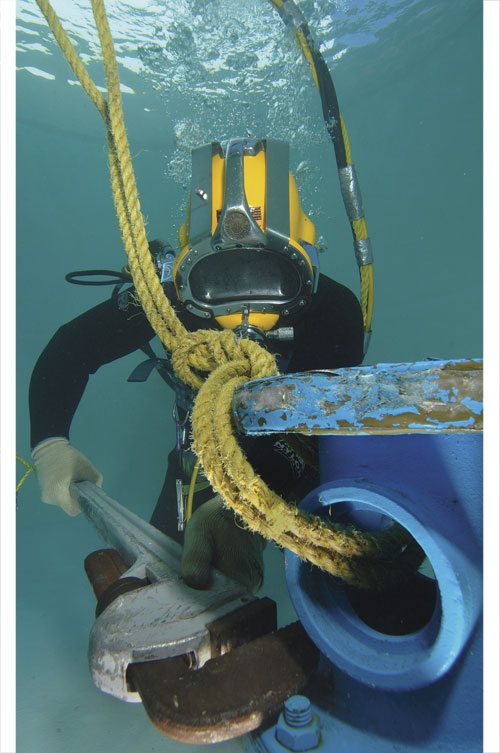 If you’re like a lot of divers, you sometimes think about throwing in the proverbial towel and trading your desk job for one that’s a little less mundane, and a little more exciting. Those few days or weeks you spend diving are the highlight of your year, and you find yourself asking, why not? Why not try to turn my avocation into a vocation? Why not get a little deeper into diving? Why not become a commercial diver? If you’ve ever found yourself uttering those words beneath your breath, then you may want to consider a career that will take you beneath the seas.
If you’re like a lot of divers, you sometimes think about throwing in the proverbial towel and trading your desk job for one that’s a little less mundane, and a little more exciting. Those few days or weeks you spend diving are the highlight of your year, and you find yourself asking, why not? Why not try to turn my avocation into a vocation? Why not get a little deeper into diving? Why not become a commercial diver? If you’ve ever found yourself uttering those words beneath your breath, then you may want to consider a career that will take you beneath the seas.
The Essence of Commercial Diving
Commercial diving is a term that covers a remarkably broad spectrum of activities. It involves a variety of trades and skills, all of which are complicated by the hostile environment in which they are performed. Jobs like welding are tough, but even tougher when performed in the inky, cold blackness 400 feet below the surface.
While most people associate commercial diving with the offshore oil industry, there is also a lot of inland commercial diving. This includes support for everything from nuclear power plants to bridge inspection and repair to building and repairing wastewater treatment facilities. Regardless of what kind of commercial diving it is, it requires a skill set far afield from recreational diving, and quite unlike anything else at all. A commercial diver must be equally capable of performing a multitude of different tasks, and in much more demanding situations than other tradesmen.
Requirements and Prerequisites
At the outset, the requirements for becoming a commercial diver are not overly difficult to meet. “The basic requirements include a high school diploma or equivalency. Applicants must also pass a diving physical,” says Bob Browning of The Ocean Corporation in Houston.
Beyond the basic requirements are good swimming skills, and a strong desire to take on a difficult challenge. “A strong mechanical inclination is another important trait for anybody who wants to be a commercial diver,” Garber says. “A potential candidate ought to at least know what a crescent wrench is and how to use it.”
Age can also be an important factor when considering a career in commercial diving. “After age 45, divers are usually restricted from deep diving for physiological reasons,” says Browning, “so most companies prefer to hire commercial divers who are younger. We find that people in the range of 18 to 35 years old are the most desired by prospective employers. We will train people older than 35, but only with a waiver.”
Despite the desire for younger divers, the commercial diving industry isn’t devoid of opportunities for those who have reached middle age and beyond. “We had one student who completed our program at age 59,” Garber says. “It was just something he always wanted to do. And as it turned out, he found work in the inland and coastal sector of commercial diving.”
Most people also see commercial diving as a “man’s world,” but Judy Lough of Santa Barbara City College in Santa Barbara, California, says about 3 percent to 6 percent of its students are females. “They do really well and have no more difficulty finding a job as a commercial diver than do the guys,” Lough says. John Paul Johnston, executive director of the Divers Institute of Technology in Seattle, agrees. “We have about 10 percent women attending our school, and they do a fantastic job. I think it’s a great career for women to consider.” The bottom line really is the desire to achieve and willingness to work hard.
Training Programs and Certification
There are broad variations in the format and content of commercial diver training programs. A program that provides the basic entry-level commercial diver certification will cost around $8,000, and take roughly two months to complete. However, many schools provide a more extensive training curriculum that costs the student between $15,000 and $20,000, and will take four to twelve months to complete, depending on the schedule and format of the program. In addition, there are schools that offer commercial diver training and certification as part of an accredited two-year college degree program.
Despite their differences, a common thread in the fabric of commercial diver training is commercial diver certification. To be eligible to work as a commercial diver, one must hold the proper certification. The Association of Diving Contractors International (ADCI), founded in 1968, is a nonprofit organization that was formed to establish industrywide standards for commercial diving in the United States. Although ADCI has no regulatory jurisdiction, it has more than 500 member companies representing business, educational and medical communities from 41 nations around the world, and is considered the industry watchdog for safe commercial diving.
Among its various functions, the ADCI sets standards for various levels of commercial diver certification, as well as for ROV pilots and technicians. The basic ACD Commercial Diver certification is Entry Level Tender/Diver. To earn more advanced certifications, a diver must log experience in the field (called “field days”) and underwater (referred to as “working dives”). Divers are required to receive on-the-job training to be eligible for more advanced commercial diver certification unless they received the required formal training through an accredited commercial diving school, military dive school, or the equivalent.
The Association of Commercial Diving Educators (ACDE) through an American National Standards Institute (ANSI) American national standard prescribes the educational content of commercial diver training programs. Referred to as ANSI-1988, the standard dictates the minimum training requirements and general curriculum that must be met for accreditation by the ACDE. The ACDE prescribes a broad curriculum for commercial diver certification, which exceeds the basic ADCI requirements for its Entry Level Tender/Diver, but includes the training requirements for the advanced commercial diver certifications such as Mixed Gas Diving. The minimum requirements prescribed by ACDE/ANSI-1988 tally up to 625 hours of training. Students who complete an ACDE-accredited program are eligible for an ACDE/ANSI-1988 Commercial Diver Certification.
While ACDI and ACDE certifications are accepted by U.S. commercial diving companies, even those who work overseas, additional certification is generally required for those seeking foreign employment as a commercial diver. Commercial divers generally must be certified in the country where they are employed. For example, divers employed in Canada would require certification from the Diver Certification Board of Canada (DCBC); those employed in Australia would fall under the jurisdiction of the Australian Diver Accreditation Scheme (ADAS); and those in the UK require certification by the Health and Safety Executive (HSE). As Johnston says, the International Marine Contractor Association (IMCA) commercial diver certification is now recognized throughout most of the rest of the world.
The content of a typical commercial diver training program includes a variety of subjects. The ANSI-prescribed curriculum includes such diverse topics as diving physics; decompression tables and procedures; anatomy and physiology; diving diseases; treatment of diving injuries; first aid and CPR; seamanship and rigging; lightweight diving equipment and procedures; operations planning; dive logs, records, and Standards for Commercial Diving; maintenance of diver’s umbilical, underwater tools; drawings, blueprints and report writing; welding and cutting; mixed-gas diving; marine engines and compressors; and industrial and offshore safety.
Degree Programs
Santa Barbara City College in Santa Barbara, California, offers an associate’s in science degree in marine diving technologies (MDT). Beyond its ACDE/ANSI-1988 accredited program, available electives include such diverse topics as emergency medical technician (EMT) training, biological oceanography, ROV sonar operation, electronics, and underwater crime scene investigation. “As an educational institution, we do encourage our students to complete their associate’s degree before entering the workforce,” Lough says. “Often after four to six years of working as a commercial diver, they want to return to school to complete a bachelor’s degree and take advantage of other opportunities. It’s easier if they already have their associate’s degree out of the way.”
Whether or not you consider a degree program, one often important factor is that a commercial diving school be federally accredited. This allows a qualified student to receive a financial aid package consisting of federal loans and grants – usually adequate to cover the cost of the training program.
While not typically necessary, a background in recreational diving is a plus when it comes to commercial diver training. As a recreational diver, familiarity with the underwater environment, and at least a cursory understanding of the physics and physiology involved with putting a human body underwater can give a recreational diver a bit of an edge, at least in the initial stage of training.
“Even a dive instructor might find that his background and knowledge is a help only for the first few days,” Tamara Brown says. “After that, he might find himself struggling to keep his head above water along with everyone else.”
A few commercial diving programs, such as the Minnesota Commercial Diving Training Center, require its students to be certified as a sport diver before admission. As owner and president, Bill Matthies says that requiring students to be scuba-qualified helps keep the school’s training program affordable and efficient. Its eight-week program is the shortest in the industry, but to achieve that goal the school also limits classes to a dozen students. “We have class 10 hours a day, six days a week,” says Matthies, “and we break our students up into two pods of six people, so that every student gets to do every job, including diving and tending, every day. We also train in a variety of open-water environments so our students get lots of experience. In addition to our 13-foot training pool, we dive in the Mississippi River where it’s ‘fast and dirty,’ and in nearby iron mines that offer depths to more than 500 feet [152 m].”
Commercial diving school is decidedly tough. Browning says that only about 72 percent of those who begin Ocean Corp’s program will finish. “Some of the tougher parts of the academic program are the decompression tables, physiology, and nondestructive testing. But more of our students drop out for personal or ‘life issues’ than because of academic problems.”
Job Prospects and Pay
Much of the current demand for commercial diving in the United States is repairing oil rigs as a consequence of hurricanes. Another area of high demand is the surge of inspection and repair of bridges, dams and other structures due to floods.
For those willing to take on the demands of commercial diving, the rewards are generous. Starting annual pay for a commercial diver is in the $40,000 to $60,000 range, including full benefits. Once a diver gains experience and proves himself, the pay can grow to $100,000 to $150,000 a year. “Most of our graduates start out with jobs in the Gulf of Mexico, where they start out making around $1,800 per week,” Browning says. He also says that there is more to look at than just the base pay and benefits, with lots of incentives being offered. A commercial diver can earn a variety of incentives and bonuses, including a hat bonus, safety bonus, and recruiting bonus. Divers earn “depth pay” or additional incentives ranging from $1 to $4 per foot for working at depth. Saturation diving earns even higher incentives.
Despite the fact that the demand for commercial divers is high, Brown stresses the importance of getting solid training. “Right now there’s a boom in commercial diving, and everybody is getting hired, but that won’t last forever. Commercial diving is historically a cyclical business, and anybody who enters it should be prepared for the slow times. As part of Divers Academy International’s 30-week training program, divers learn a lot of skills that translate to topside jobs, including nondestructive testing, welding, hazardous material handling, and rigging.”
An eye toward the future should include consideration of nondiving work in the industry. If a diver suffers an injury or develops a medical condition that precludes diving, having topside skills are an ace up the sleeve. Oftentimes, commercial divers entering their mid 40s or 50s will move on to other jobs where their skills and knowledge can be applied.
The Fast Track
Considering the high earnings potential for commercial diving, the price of becoming a commercial diver is a bargain. Ocean Corp’s 30-week commercial diver program is $16,000, and federal financial aid is often available for qualified students. “In addition,” Browning says, “Many companies who hire divers have incentive programs to pay for all or part of a diver’s training when they sign a 25-month work contract.”
Compared with other career paths, commercial diving is a fast track to high earnings. Consider that six months of commercial diver training at a cost of $20,000 can lead to a job with starting pay in the $40,000 to $60,000 range, with earnings potential of more than $100,000 per year. It’s difficult to find other forms of career training that cost so little yet offer as high an earning potential and such a high demand for graduates.
Although the financial reward is substantial, the job is not an easy one. “Those divers earn every penny they make,” Garber says. “A lot of guys who go into it thinking it’s an easy way to make a fast buck quickly learn otherwise.”
The Realities of Commercial Diving
Despite what might sound like “easy money,” commercial diving is hard physical work, and there’s not much in the way of sitting around on coffee breaks. Don’t expect to be packing your lunchbox for a 9-to-5 day as a commercial diver, either. A commercial diver in the Gulf might be out at sea working for two to six weeks at a time, which is tough on some individuals. Ten-hour workdays are also common in the industry.
Within the realm of commercial diving are two broad categories that offer distinct advantages for different lifestyles. First is the offshore diving industry, which offers more international travel. Offshore commercial divers are usually away from home for longer periods of time, as much as six weeks at a time with one week off in between. Inland and coastal commercial diving may be a better fit for those with families who prefer not to be away for as long at a time. Often, divers in this sector of commercial diving will have more “normal” working hours and shorter days, allowing them to spend more time at home. However, even the inland and coastal commercial diver may still travel for weeks at a time to perform the work required by larger contracts.
If your current job lacks the excitement and adventure you long for, and you don’t mind hard physical work, then commercial diving might offer just the career path you’re looking for. With the right training, you can get in deep, without getting in over your head.
Choosing a Commercial Diving School
Training to become a commercial diver is available from a variety of schools across the United States, and while they all certify commercial divers, there are distinct differences in their offerings. The challenge is to decide which school offers the best package for you. Here are some of the questions you may want to consider when making that important choice:
- When can I start training, and how long will the training program run?
- What is the training environment and schedule like, and how much hands-on experience will I receive?
- Beyond the ADC Commercial Diver Certification, what additional certifications such as diver medical technician, ROV pilot/technician, nondestructive testing (NDT), and Hazardous Worker (HAZWOPR) will I receive? Does the training include everything required for all advanced ADCI certifications?
- How is the school accredited, and can I receive credit for my commercial diver training toward a college degree?
- Is financial aid available, and can I take advantage of veteran’s benefits?
- What are the additional costs above the tuition, such as books, equipment, and room and board?
- Will I be prepared for career changes if and when such needs arise?
- Where are graduates getting jobs, and how will the school help place me where I want to work?
View a list of Commercial Diving Schools
What Commercial Divers Do
Commercial divers perform a spectrum of work activities that entail a variety of hard-won skills. The following list identifies some of the jobs that commercial divers may perform. These jobs may be performed in a variety of diving environments and depths.
Bridge inspection, construction and repair
Fabrication of equipment
Flotation devices maintenance
Gravity surveying
Grouting
Guideline replacement
Hyperbaric chamber operations
Injection equipment installation
Life-support systems construction, operation,
repair and maintenance
Marine environmental control check
Medical and emergency care for diving illnesses and accidents
Operation of 1-atmosphere suits
Operation of remotely operated vehicles (ROV)
Operation of diving bells
Platform construction, inspection, maintenance and removal
Rock drilling and blasting
Salvage
Search and recovery
Seismic surveying
Sewage line installation and maintenance
Site surveys prior to installation
Submersible operations
Surface geological appraisal
Trenching or underwater jetting
Underwater inspection, installation, repair and maintenance
Underwater painting
Underwater photography and videography
Underwater surveys
Underwater welding and cutting
Water line installation, inspection, repair and maintenance
Wellhead repair and maintenance

